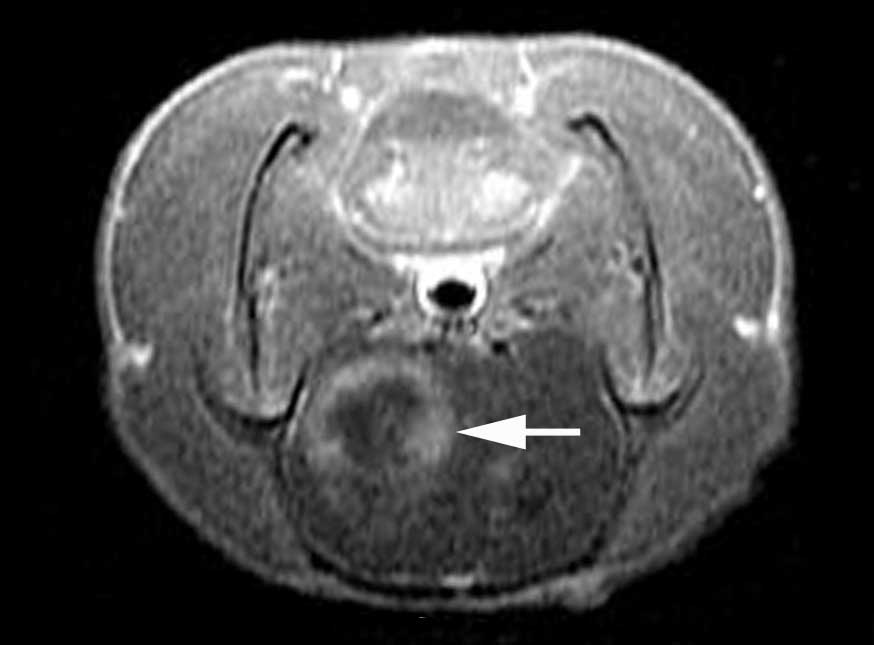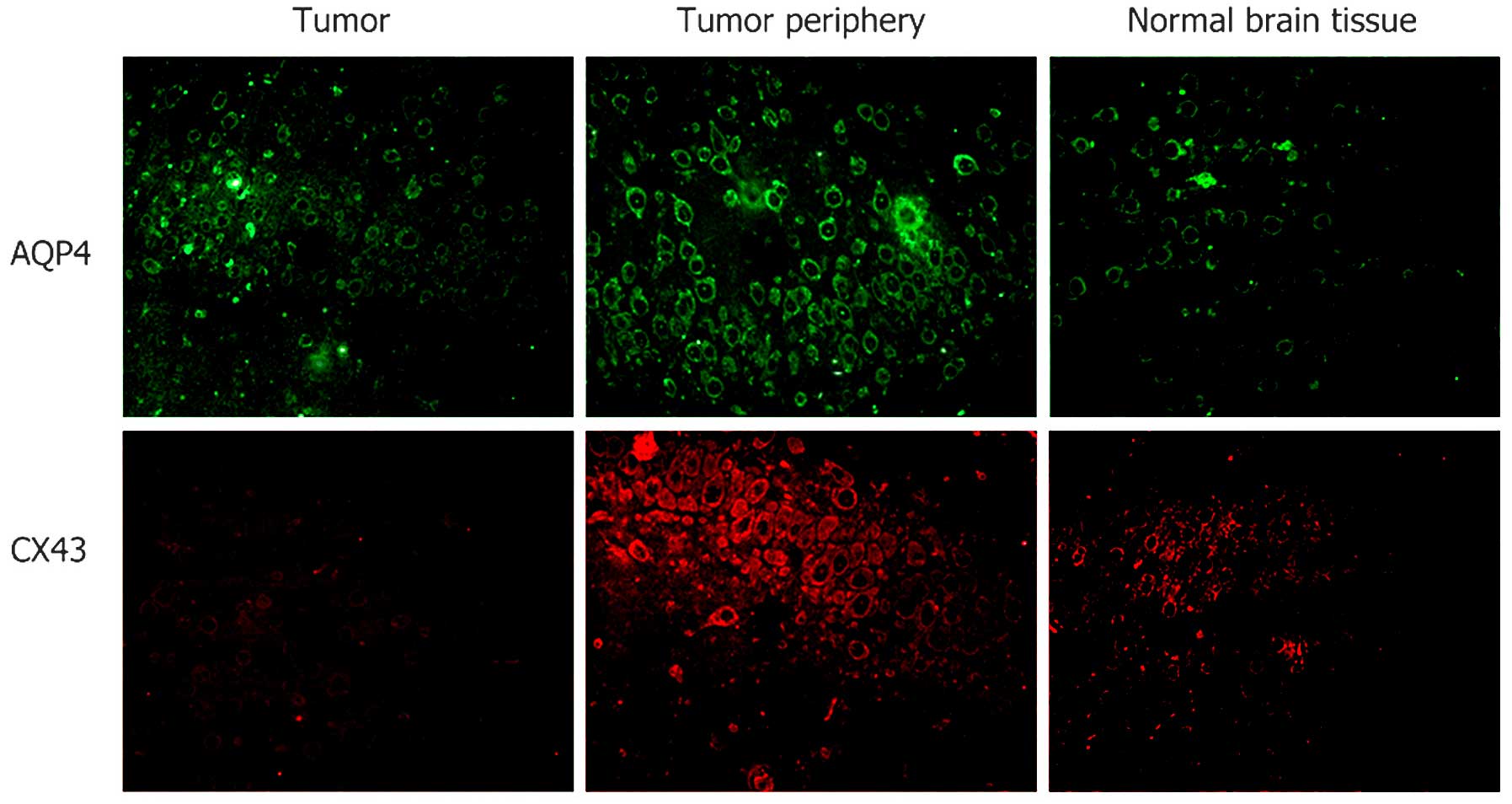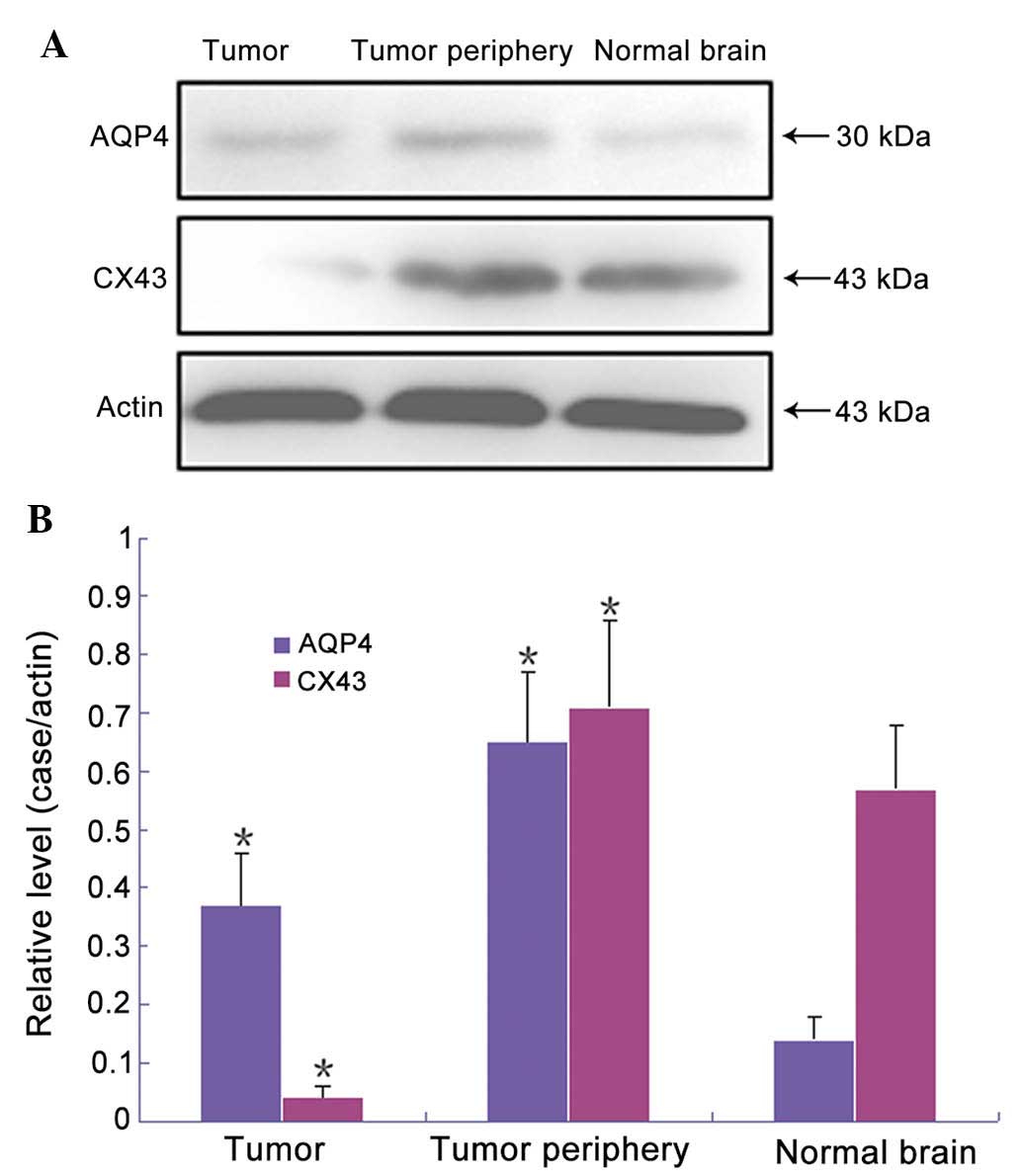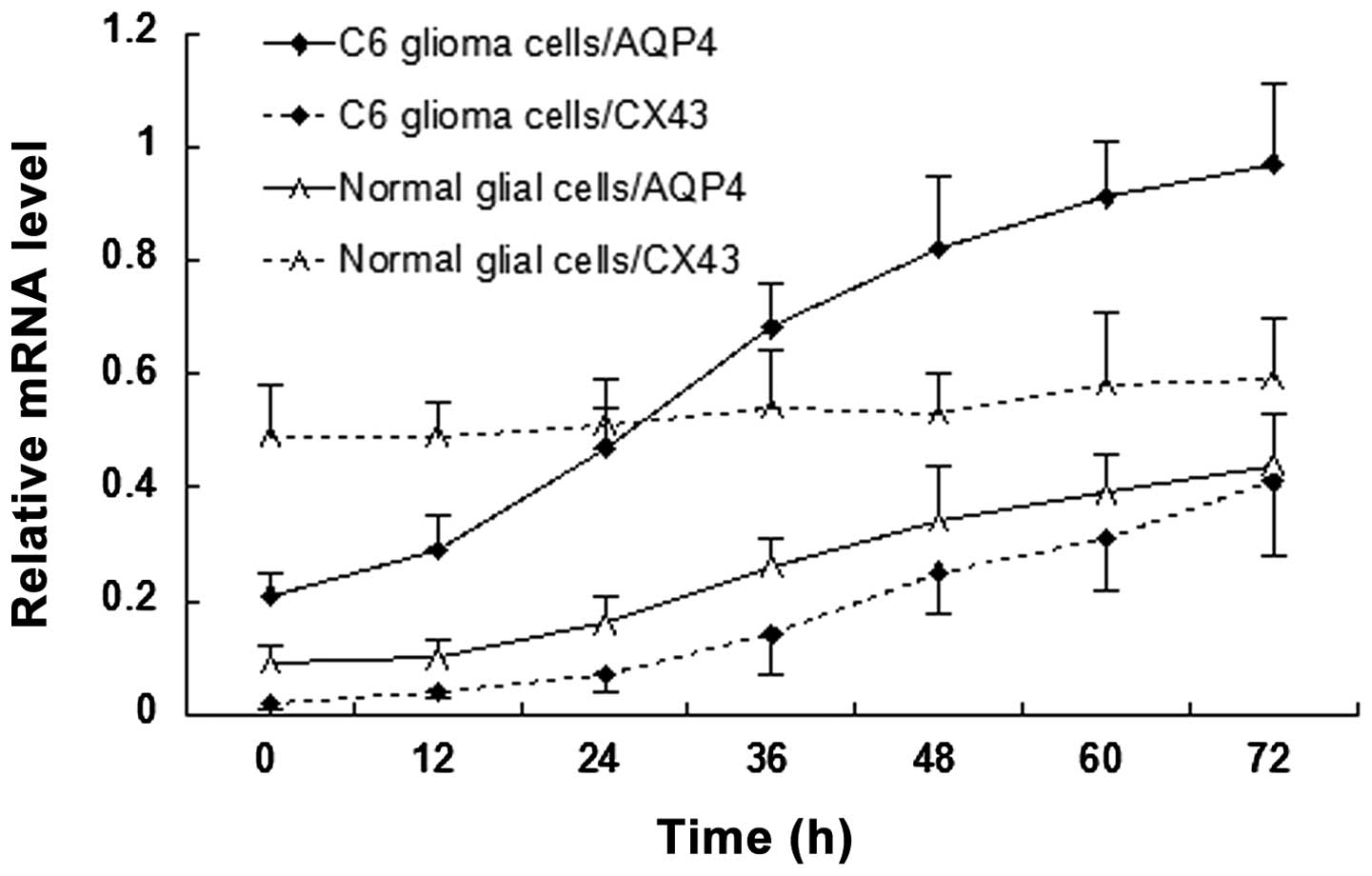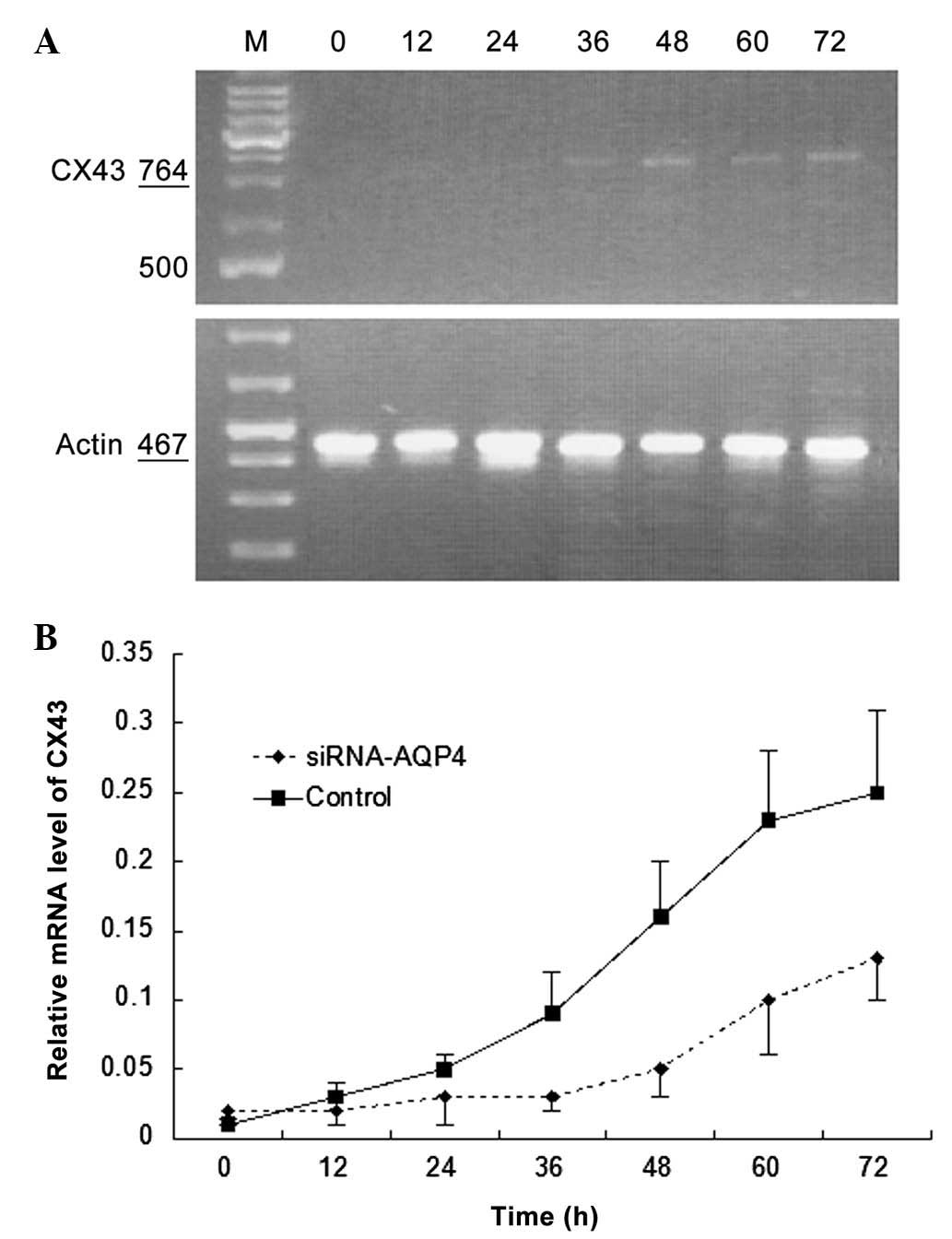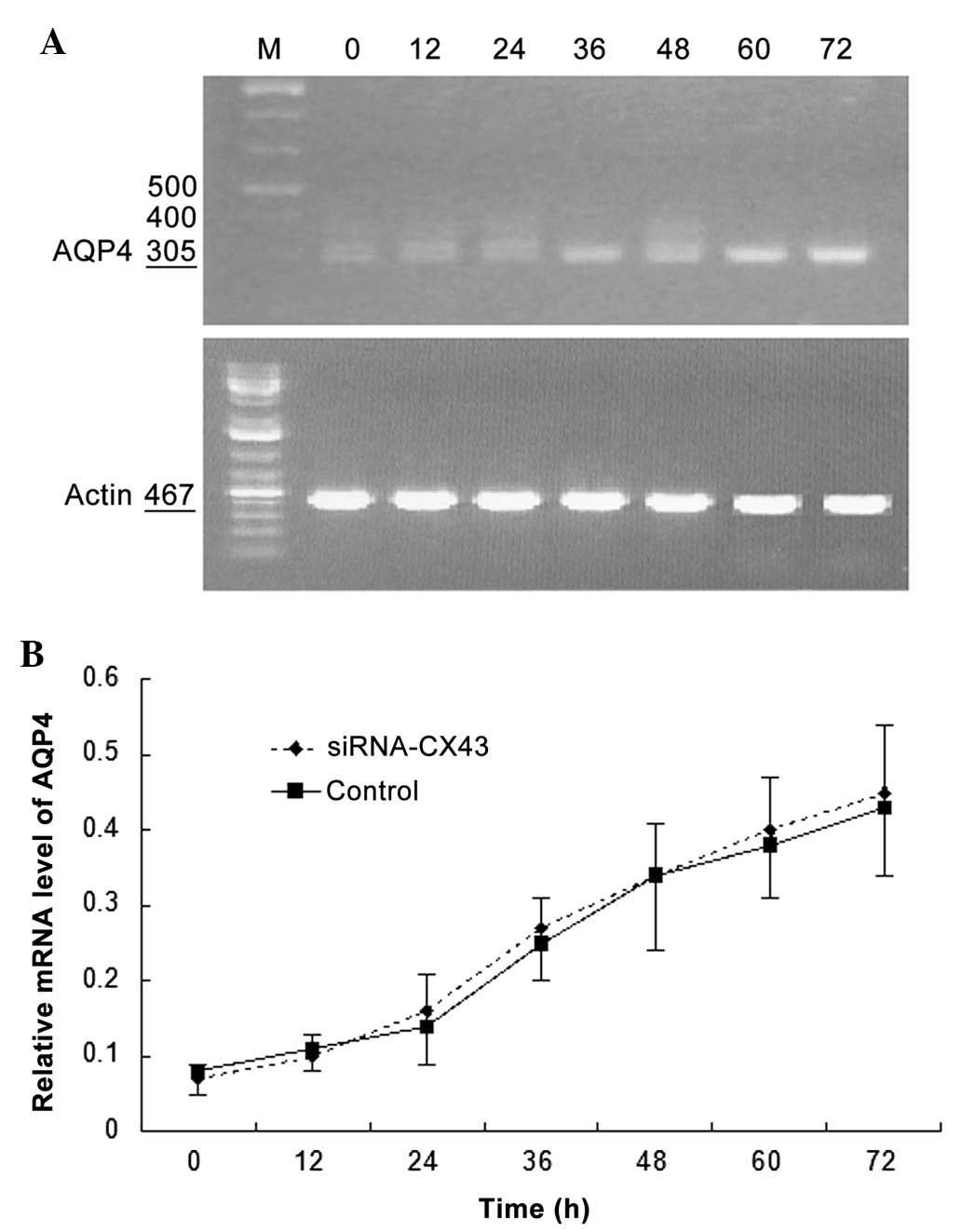Interactions of connexin 43 and aquaporin-4 in the formation of glioma-induced brain edema
- Authors:
- Published online on: November 5, 2014 https://doi.org/10.3892/mmr.2014.2867
- Pages: 1188-1194
Abstract
Introduction
Glioblastoma accounts for ~10% of intracranial tumors and ~22.3% of neuroepithelial tumors and is the second most common intracranial tumor (1,2), mainly occurring in individuals aged 30–50 years. The ratio of male to female incidence is ~2.5:1 (1,3). Glioblastoma located under the cortex displays infiltrative growth and frequently encroaches upon multiple brain lobes, has a deep structure and spreads to the contralateral cerebral hemisphere via the corpus callosum (4). Glioblastoma is highly malignant, grows rapidly and has a short disease progression (5). Symptom appearance is commonly within three months, and within six months in ~70–80% of patients (6).
The rapid growth of glioblastoma is associated with extensive cerebral edema and marked intracranial hypertension (7,8). The majority of patients suffer from headaches, vomiting and papilledema. Computed tomography revealed lesions with inhomogeneous density, unclear boundaries and apparent brain edema surrounding the lesions (9). Enhancement scanning further revealed inhomogeneous enhancement or rim enhancement (10). At least one third of all glioblastoma mortalities are a result of brain edema and herniation (11). The hyperosmotic dehydrants, diuretics and hormones currently used for the symptomatic treatment of glioblastoma have poor outcomes (12); therefore, it is important to elucidate the molecular mechanisms underlying the development of glioblastoma-induced brain edema in order to aid in the development of more effective treatment plans.
Cell-cell communication is the basis of molecular transmission and transport among connecting cells (13–15). Connexin is composed of six polygonal subunits arranged in a circular shape to form a hydrophilic channel (16). This channel allows the transport of ions, sugars, nucleotides, fatty acids and low-molecular-weight polypeptides, as well as certain drugs and carcinogens whose molecular weight is below 1,000–1,600 Da (17–21). Connexin 43 (Cx43) is expressed in the brain with a high specificity and forms the structural basis for substance transfer among neurons and accessory cells, in particular, glial cells (22,23). Aquaporins are a family of water channel proteins that have critical roles in regulating the water content of cells under pathological and physiological conditions (24–26). Aquaporin-4 (AQP4) is specifically expressed in the brain and spinal cord, where it has an important role in maintaining the correct water balance in brain tissues (27,28).
Previous studies have mainly focused on the role of single genes in glioma-induced brain edema formation and have rarely analyzed the interaction between genes (29). The present study aimed to evaluate differences in Cx43 and AQP4 expression levels in glioblastoma tumors and the surrounding edema in vivo, in order to aid elucidation of the mechanisms underlying edema formation.
To further investigate the interaction between Cx43 and AQP4 in glioblastoma-induced brain edema formation, hypotonic medium was used to simulate the environment of brain edema in vitro and determine the effects on AQP4 and Cx43 messenger RNA (mRNA) expression levels in C6 glioma cells and normal glial cells. The effects of silencing of AQP4 in C6 glioma cells and Cx43 in glial cells under hypotonic conditions were also evaluated. The results of the present study may present a novel perspective on the mechanisms underlying glioma-induced brain edema formation and therefore aid in the development of drugs targeting the interaction between AQP4 and Cx43 for the treatment of glioma-induced brain edema.
Materials and methods
Reagents and animals
Murine C6 glioma cells (Shanghai Cancer Institute, Shanghai, China), fetal bovine serum (Hangzhou Sijiqing Biological Engineering Materials Co., Ltd., Huzhou, China), Dulbecco’s modified Eagle’s medium and trypsin (Gibco-BRL, Invitrogen Life Technologies, Carlsbad, CA, USA), Lipofectamine® 2000 (Invitrogen Life Technologies), short interfering RNA (siRNA) targeting AQP4 and Cx43 (synthesized by Wuhan Genesil Biotechnology Co., Ltd., Wuhan, China), reverse transcription quantitative polymerase chain reaction (RT-qPCR) kit (Beijing Zhongshan Co., Beijing, China), PCR primers (synthesized by Beijing Sunbiotech Company, Beijing, China), rabbit anti-rat Cx43 polyclonal antibody (Chemicon, Billerica, MA, USA) and rabbit anti-rat AQP4 polyclonal antibody (Santa Cruz Biotechnology Inc., Dallas, TX, USA) were used in the present study. A total of 20 male Sprague-Dawley rats aged 7–8 weeks and weighing 200±10 g were purchased from the Animal Center of Academy of Military Medical Sciences (Beijing, China) and housed in the Experimental Animal Center (Tianjin Medical University, Tianjin, China) under controlled temperature (22~24°C) conditions with a 12 h light/dark cycle. The lights were on from 8:00 to 20:00. Food and water were made available ad libitum. Experiments were performed during the light phase of the cycle. All experimental procedures were carried out according to the regulations and internal biosafety and bioethics guidelines of Tianjin Medical University and the Tianjin Municipal Science and Technology Commission
Establishment of intracranial glioma model and magnetic resonance imaging (MRI)
C6 glioma cells in the logarithmic phase were digested into a single cell suspension. Rats were anesthetized by intraperitoneal injection of ketamine/xylazine (100 g/kg ketamine, Parke-Davis, New Jersey, USA; 5 mg/kg xylazine, Bayer AG, Leverkusen, Germany), and then were fixed on benches with a stereotactic injection device and shaved. A C6 glioma cell suspension (1×106 cells in 25 μl) was injected into the brain in the right caudate nucleus. The duration of injection was >5 min, following which the needle was maintained for at least three minutes and the incision was subsequently sutured. Cranial MRI was conducted at 3, 6, 9 and 12 days post-injection to observe tumor growth and edema.
Immunofluorescence to analyze the spatial expression of Cx43 and AQP4 within and surrounding the glioma
Following the final MRI examination (12 days post-injection), the rats were sacrificed by cervical dislocation. Brain tissues containing the glioma were embedded in paraffin (Zhongshan Biocorp., Beijing, China), sliced into sections and analyzed using immunofluorescence. Briefly, sections were boiled for 5 min in Tris (10 mM)/ethylene diamine tetra acetic acid (1 mM, Zhongshan Biocorp.; pH 9.0) buffer for antigen retrieval, treated by Triton X-100 (Zhongshan Biocorp.), and were blocked with serum (Hangzhou Sijiqing Biological Materials Co., Ltd., Hangzhou, China) for one hour, treated with rabbit anti-rat Cx43 polyclonal antibody (1:500) and rabbit anti-rat AQP4 polyclonal antibody (1:1,000) at 4°C overnight. The sections were subsequently incubated with fluorescein isothiocyanate (FITC)- or tetramethylrhodamine isothiocyanate (TRITC)-labeled secondary antibodies (FITC or TRITC goat anti-rabbit IgG; Santa Cruz Biotechnology Inc.), followed by mounting and observation under a fluorescence microscope(Olympus DP 70, Tokyo, Japan).
Western blot analysis for quantitative detection of Cx43 and AQP4 expression levels within and surrounding the glioma
The remaining brain tissues containing gliomas were dissected. Tumor tissue and 5 mm of the surrounding tissue were stored in liquid nitrogen prior to extraction of total proteins. Total protein was extracted using standard lysis buffer (Sigma, St. Louis, MO, USA) for 10 min The proteins were quantified using the Bradford method (30), separated by 10% SDS-PAGE and transferred onto polyvinylidene difluoride membranes. The membranes were blocked with skimmed milk (Zhongshan Biocorp.) for one hour, washed with phosphate-buffered saline (Zhongshan Biocorp.) and incubated with primary antibodies (anti-Cx43, 1:500; AQP4, 1:1,000) at 4°C with horizontal shaking overnight. The following day, the membranes were treated with horseradish peroxidase-labeled secondary antibodies (1:500) at 37°C for two hours and visualized using a Chemiluminescence Detection Kit (Weifang Kanghua Biotech Co., Ltd., Shandong, China). Bio-Rad imaging system (Bio-Rad Laboratories, Hercules, CA, USA) was used to measure absorbance values at a wavelength of 570 nm. Quantity One software version 4.4.1 (Bio-Rad Laboratories) was used to analyze the data. The dilution of the control β-actin antibody was 1:200.
RT-qPCR for the characterization of AQP4 and Cx43 expression in a hypotonic environment
Subcultured C6 glioma cells and primary cultured normal glioma cells were separately incubated in hypotonic medium at 250–260 mOsm/kg. AQP4 and Cx43 mRNA expression was determined in C6 cells and normal glial cells at 0, 12, 24, 36, 48, 60 and 72 hours. The primers used for analysis were as follows: AQP4 forward, 5′-CCA GCT GTG ATT CCA AAA CGG AC-3′ and reverse, 5′-TCT AGT CAT ACT GAA GAC AAT ACC TC-3′ (product size, 305 bp); Cx43 forward, 5′-TGT AAC ACT CAA CAA CCT GGC-3′ and reverse, 5′-GAT CTT GAT CTT CAT GGT GCT AGG-3′ (product size, 764 bp). Reaction conditions were as follows: 32 cycles of denaturation at 94°C for 30 sec, annealing at 56°C for 30 min and extension at 72°C for 1 min, followed by extension at 72°C for 10 min. Time x represents an arbitrary time-point. Time 0 represents a 1-fold target gene expression following β-actin correction. ΔΔCT was calculated using the formula (CT.Target−CT.U6)Time x−(CT.Target−CT.U6)Time 0.
AQP4 and Cx43 gene silencing
AQP4 and Cx43 full-length mRNAs were retrieved from the NCBI gene database (http://www.ncbi.nlm.nih.gov/gene). siRNA was designed with gene silencing design software in the coding regions. The oligonucleotide sequence targeting AQP4 was 5′-AGA TCA GCA TCG CCA AGT C-3′, and that targeting Cx43 was 5′-UUG AAG UUA UGU AUC CUC CUU-3′. C6 glioma cells and glial cells that were growing successfully were selected for transfection and their media was replaced with fresh media on the day prior to transfection. For transfection, 1 μg plasmid DNA and 100 μl LipoVec™ (Santa Cruz Biotechnology, Inc.) were mixed for 20 min. The mixture was added to the medium for 4 h and subsequently the medium was replaced by medium containing 20% serum. Following 48 h of transfection, fresh medium containing 200 ng/l geneticin (Zhongshan Biocorp.) was used for selection. The selective medium was replaced every three days. Following 14 days of culture, cell colonies were visible in successfully transfected groups, whereas all non-transfected cells had died. When the number of positive cells reached a certain number, cell clones were transferred into 24-well plates for further passaging. These cells were incubated in hypotonic conditioned medium (Zhongshan Biocorp.) at 250–260 mOsm/kg. AQP4 and Cx43 mRNA expression levels were detected at 0, 12, 24, 36, 48, 60 and 72 h using the method described above.
Statistical analysis
Experiments were repeated three times. Data were processed using SPSS 13.0 software (SPSS Inc., Chicago, IL, USA). Values are expressed as the mean ± standard deviation. To evaluate differences amongst the groups, χ2 analysis was performed. A value of P<0.05 was considered to indicate a statistically significant difference between values.
Results
Establishment of intracranial glioma models and MRI examination
As displayed in Fig. 1, which was captured on the 10th day post-C6 glioma cell injection, the examination revealed circular tumor shadows in the brain of Sprague-Dawley rats. Cystic degeneration or necrosis was observed in the center of certain tumors. Edema (>5 mm; Fig. 1, red arrow) was observed on the periphery of the majority of tumors evaluated.
AQP4 and Cx43 expression levels are higher in the tumor periphery than those in the center
In Fig. 2, green fluorescence indicates FITC-labeled AQP4, and red fluorescence indicates TRITC-labeled Cx43. AQP4 and Cx43 were expressed at low levels in normal brain tissues. In glioma cells, AQP4 was expressed at low levels and Cx43 was expressed at low to non-detectable levels. In the 5-mm area of tissue surrounding the glioma, significantly higher expression levels of AQP4 and Cx43 were detected.
AQP4 and Cx43 expression levels are altered in glioblastoma tissues
As exhibited in Fig. 3, relative expression levels of AQP4 were significantly higher in tumor tissues than those in normal brain tissues (0.37±0.09 vs. 0.14±0.04), whereas Cx43 expression levels were significantly lower in tumor tissues than those in normal brain tissues (0.04±0.02 vs. 0.57±0.11). In the edema tissue surrounding the tumor, the relative expression levels of AQP4 were significantly higher than those in normal brain tissues (0.65±0.12). Expression levels of Cx43 were higher than those in normal brain tissues, while there was no significant difference (0.71±0.15). Significant differences were detected between the experimental groups and the control group, as determined by paired comparisons (P<0.05).
AQP4 and Cx43 mRNA expression levels change with time under hypotonic conditions
The mRNA expression levels of AQP4 and Cx43 in C6 glioma cells and normal glial cells are revealed in Fig. 4. AQP4 mRNA expression was detected in C6 glioma cells (0.21±0.04) and rapidly increased with time under hypotonic conditions. AQP4 mRNA expression levels were lower in normal glial cells (0.09±0.03) than those in C6 glioma cells and slowly increased with time under hypotonic conditions. Cx43 mRNA expression levels in C6 glioma cells were initially lower than those in normal glial cells (0.02±0.01 vs. 0.49±0.09). Although Cx43 mRNA expression levels in C6 glioma cells increased with time under hypotonic conditions, the expression levels remained lower than those of Cx43 and AQP4 in C6 glioma cells. An inflection point appeared 24 h following hypotonic cultivation, which was later than that of C6 glioma cells (12 h). No significant increase in Cx43 mRNA expression was detected in normal glial cells with prolonged time under hypotonic conditions.
AQP4 silencing attenuates the increase in Cx43 expression characteristic of C6 glioma cells
Fig. 5A reveals Cx43 mRNA expression following selective AQP4 silencing in C6 glioma cells. Cx43 mRNA expression levels increased with prolonged time in C6 glioma cells under hypotonic conditions and the proportion of increase was significantly higher than that of the control group (P<0.05; Fig. 5B).
Cx43 silencing has no significant effect on AQP4 expression in normal glial cells
Fig. 6A shows AQP4 mRNA expression in normal glial cells following selective Cx43 silencing. AQP4 mRNA expression gradually increased over time in normal glial cells under hypotonic conditions and the increase was similar to that of the control group (P>0.05; Fig. 6B).
Discussion
Brain edema is characterized by an excessive accumulation of fluid in the intracellular or extracellular spaces of the brain (31). Various intracranial pathological changes, including hypoxia, poisoning, metabolic disturbance, craniocerebral injury, tumors, abscesses, blood vessels and inflammation, may induce increased fluid content in the brain parenchyma, resulting in intracranial hypertension, which may induce alterations in cerebral metabolism, blood supply and aggravated brain edema (10). When glioblastoma initially develops, edema in neoplastic cells and the tumor nidus is not apparent (32). Following increased tumor nidus and tumor blood vessel growth, the blood-brain barrier in the focal zone is damaged, capillary permeability increases and plasma components and water are released, triggering angioedema (33). Endothelial cells are subsequently destroyed and tight connections in the vascular endothelial cell membrane are opened. Water and partially ionic compositions overflow and enter the tumor periphery (34). Normal cells at the tumor periphery are subjected to hypotonic conditions for extended time-periods; therefore, the dynamic configuration of the membrane is damaged, resulting in dysfunction of the membrane transport system for water and electrolytes; Ca2+ release from the mitochondria and endoplasmic reticulum, which increases the intracellular Ca2+ concentration; activation of phospholipase A and C and induced phospholipase degradation, resulting in arachidonic acid release, increased cell permeability and cellular dysfunction (34,35). Therefore, the mitochondria, lysosomes, microsomal membranes and subcellular organelles are destroyed, resulting in dysfunction of neurons and accessory cells and aggravation of brain edema (36). It was hypothesized that glioblastoma-induced brain edema is a combination of angioedema and cytotoxic brain edema (37). In the present study, angioedema was mainly detected in the tumor nidus and cytotoxic edema was mainly detected in the tumor periphery.
In the present study, a Sprague-Dawley rat model of intracranial glioma was established. MRI examination revealed tumor formation and edema at the tumor periphery. Immunofluorescence analysis and western blot assay verified marked differences in AQP4 and CX43 expression in the tumor bed and the tumor periphery. In cells of the tumor bed, AQP4 expression levels increased, whereas Cx43 expression decreased or was absent in comparison to those of normal brain tissues. However, AQP4 expression levels were significantly increased and Cx43 expression levels were higher in the edema region at the tumor periphery compared with those of normal brain tissues.
Aside from a small number of infiltrative glioma cells, abundant normal glial cells were visible at the tumor periphery. Normal glial cells also expressed AQP4 and Cx43 to a certain extent. The present study hypothesized that edema formation in the tumor bed was associated with glioma cells, whereas edema at the tumor periphery was associated with normal glial cells. Therefore, C6 glioma cells and normal glial cells were separately incubated under hypotonic conditions to simulate edema, in order to characterize AQP4 and Cx43 expression in both cell types. The results demonstrated that AQP4 mRNA expression rapidly increased with time under hypotonic conditions in C6 glioma cells, whereas it increased slowly in normal glial cells. Simultaneously, Cx43 mRNA expression levels were low in C6 glioma cells and increased with prolonged time under hypotonic conditions; however, the increase in expression levels was not so marked as that observed in that of AQP4. An inflection point appeared at 24 h following hypotonic cultivation, which was later than that observed in C6 glioma cells (12 h). No increase in Cx43 mRNA expression levels was detected in normal glial cells with time under hypotonic conditions.
To further identify the association between AQP4 and Cx43, Cx43 expression under hypotonic conditions following AQP4 silencing in C6 glioma cells was observed. AQP4 expression levels under hypotonic conditions following Cx43 silencing in normal glial cells were also evaluated. The results confirmed that the increased Cx43 expression observed in C6 glioma cells was significantly attenuated following AQP4 silencing, while AQP4 expression was not altered following Cx43 silencing in normal glial cells. Based on these results, it was concluded that AQP4 and Cx43 within and surrounding the glioma had separate mechanisms underlying brain edema and that Cx43 may be a downstream effector of AQP4. Due to the impairment of glioblastoma cell-cell junctions and communication, numerous micromolecular substances and ions are restricted in single tumor cells (38). The block in communication results in disordered transport of water molecules, ions and micromolecular substances (39). Although water transport is not a major function of cell-to-cell junctions and communication, intracellular and extracellular osmotic pressure gradients induced by the disordered transport of ions and micromolecular substances affect intracellular and extracellular water distribution, resulting in impaired intracellular water excretion and the formation of glioblastoma-induced brain edema (40).
A previous study confirmed that a hypotonic environment caused AQP4 expression levels to increase in glial cells (41). Li et al (25) found that a hypotonic environment led to astrocyte edema and a reduction in viability, with increased AQP4 mRNA and protein expression levels. Yang et al (27) suggested that when glial cells in the edema region at the tumor periphery were in a hypotonic environment, increased AQP4 expression promoted the entrance of extracellular water to cells. Intracellular water overloading would therefore induce the occurrence of cytotoxic edema. These studies did not clearly explain the mechanism underlying glioma-induced brain edema within and around the edge of the tumor. The results of the present study enhanced the available knowledge in this field and provided a novel insight into the roles of AQP4 and Cx43 in brain edema. However, further study is required in order to fully elucidate this complex pathway.
References
|
Bonavia R, Inda MM, Cavenee WK and Furnari FB: Heterogeneity maintenance in glioblastoma: a social network. Cancer Res. 71:4055–4060. 2011. View Article : Google Scholar : PubMed/NCBI | |
|
Raizer JJ, Grimm S, Chamberlain MC, et al: A phase 2 trial of single-agent bevacizumab given in an every-3-week schedule for patients with recurrent high-grade gliomas. Cancer. 116:5297–5305. 2010. View Article : Google Scholar : PubMed/NCBI | |
|
Ivliev AE, ‘t Hoen PA and Sergeeva MG: Coexpression network analysis identifies transcriptional modules related to proastrocytic differentiation and sprouty signaling in glioma. Cancer Res. 70:10060–10070. 2010. View Article : Google Scholar : PubMed/NCBI | |
|
Gerstner ER, Chen PJ, Wen PY, Jain RK, Batchelor TT and Sorensen G: Infiltrative patterns of glioblastoma spread detected via diffusion MRI after treatment with cediranib. Neuro Oncol. 12:466–472. 2010.PubMed/NCBI | |
|
Bleeker FE, Molenaar RJ and Leenstra S: Recent advances in the molecular understanding of glioblastoma. J Neurooncol. 108:11–27. 2012. View Article : Google Scholar : PubMed/NCBI | |
|
Masica DL and Karchin R: Correlation of somatic mutation and expression identifies genes important in human glioblastoma progression and survival. Cancer Res. 71:4550–4561. 2011. View Article : Google Scholar : PubMed/NCBI | |
|
Tabunoki H, Saito N, Suwanborirux K, Charupant K and Satoh J: Molecular network profiling of U373MG human glioblastoma cells following induction of apoptosis by novel marine-derived anti-cancer 1,2,3,4-tetrahydroisoquinoline alkaloids. Cancer Cell Int. 12:142012. View Article : Google Scholar : PubMed/NCBI | |
|
Yoo AS, Sun AX, Li L, et al: MicroRNA-mediated conversion of human fibroblasts to neurons. Nature. 476:228–231. 2011. View Article : Google Scholar : PubMed/NCBI | |
|
Huang PH, Miraldi ER, Xu AM, et al: Phosphotyrosine signaling analysis of site-specific mutations on EGFRvIII identifies determinants governing glioblastoma cell growth. Mol Biosyst. 6:1227–1237. 2010. View Article : Google Scholar : PubMed/NCBI | |
|
Solan JL and Lampe PD: Connexin43 phosphorylation: structural changes and biological effects. Biochem J. 419:261–272. 2009. View Article : Google Scholar : PubMed/NCBI | |
|
Huang Q, Liu XZ, Kang CS, Wang GX, Zhong Y and Pu PY: The anti-glioma effect of suicide gene therapy using BMSC expressing HSV/TK combined with overexpression of Cx43 in glioma cells. Cancer Gene Ther. 17:192–202. 2010. View Article : Google Scholar | |
|
Li W and Graeber MB: The molecular profile of microglia under the influence of glioma. Neuro Oncol. 14:958–978. 2012. View Article : Google Scholar : PubMed/NCBI | |
|
Ribot EJ, Miraux S, Konsman JP, et al: In vivo MR tracking of therapeutic microglia to a human glioma model. NMR Biomed. 24:1361–1368. 2011. View Article : Google Scholar : PubMed/NCBI | |
|
Salvati M, D’Elia A, Formichella AI and Frati A: Insights into pharmacotherapy of malignant glioma in adults. Expert Opin Pharmacother. 10:2279–2290. 2009. View Article : Google Scholar : PubMed/NCBI | |
|
Xiong Z and Ohlfest JR: Topical imiquimod has therapeutic and immunomodulatory effects against intracranial tumors. J Immunother. 34:264–269. 2011. View Article : Google Scholar : PubMed/NCBI | |
|
Brisset AC, Isakson BE and Kwak BR: Connexins in Vascular Physiology and Pathology. Antioxid Redox Signal. 11:267–282. 2009. View Article : Google Scholar | |
|
Jain RK, di Tomaso E, Duda DG, Loeffler JS, Sorensen AG and Batchelor TT: Angiogenesis in brain tumours. Nat Rev Neurosci. 8:610–622. 2007. View Article : Google Scholar : PubMed/NCBI | |
|
Papadopoulos MC, Saadoun S, Davies DC and Bell BA: Emerging molecular mechanisms of brain tumour oedema. Br J Neurosurg. 15:101–108. 2001. View Article : Google Scholar : PubMed/NCBI | |
|
Pavlisa G, Rados M, Pavlisa G, Pavic L, Potocki K and Mayer D: The differences of water diffusion between brain tissue infiltrated by tumor and peritumoral vasogenic edema. Clin Imaging. 33:96–101. 2009. View Article : Google Scholar : PubMed/NCBI | |
|
Uchida S, Sasaki S, Fushimi K and Marumo F: Isolation of human aquaporin-CD gene. J Biol Chem. 269:23451–23455. 1994.PubMed/NCBI | |
|
Mou KJ, Mao Q, Chen MN, et al: AQP4 expression in the brains of patients with glioblastoma and its association with brain edema. Sichuan Da Xue Xue Bao Yi Xue Ban. 40:651–654. 2009.(In Chinese). PubMed/NCBI | |
|
Nico B, Mangieri D, Tamma R, et al: Aquaporin-4 contributes to the resolution of peritumoural brain oedema in human glioblastoma multiforme after combined chemotherapy and radiotherapy. Eur J Cancer. 45:3315–3325. 2009. View Article : Google Scholar : PubMed/NCBI | |
|
Warth A, Mittelbronn M, Hülper P, Erdlenbruch B and Wolburg H: Expression of the water channel protein aquaporin-9 in malignant brain tumors. Appl Immunohistochem Mol Morphol. 15:193–198. 2007. View Article : Google Scholar : PubMed/NCBI | |
|
Nicchia GP, Srinivas M, Li W, Brosnan CF, Frigeri A and Spray DC: New possible roles for aquaporin-4 in astrocytes: cell cytoskeleton and functional relationship with connexin43. FASEB J. 19:1674–1676. 2005.PubMed/NCBI | |
|
Li YH and Sun SQ: Effect of hypotonic medium on expression of aquaporin-4 in astrocytes. Zhonghua Yi Xue Za Zhi. 84:496–501. 2004.(In Chinese). PubMed/NCBI | |
|
Arima H, Yamamoto N, Sobue K, et al: Hyperosmolar mannitol simulates expression of aquaporins 4 and 9 through a p38 mitogen-activated protein kinase-dependent pathway in rat astrocytes. J Biol Chem. 278:44525–44534. 2003. View Article : Google Scholar : PubMed/NCBI | |
|
Yang B, Zador Z and Verkman AS: Glial cell aquaporin-4 overexpression in transgenic mice accelerates cytotoxic brain swelling. J Biol Chem. 283:15280–15286. 2008. View Article : Google Scholar : PubMed/NCBI | |
|
Figueroa XF and Duling BR: Gap junctions in the control of vascular function. Antioxid Redox Signal. 11:251–266. 2009. View Article : Google Scholar | |
|
Criscuolo GR: The genesis of peritumoral vasogenic brain edema and tumor cysts: a hypothetical role for tumor-derived vascular permeability factor. Yale J Biol Med. 66:277–314. 1993.PubMed/NCBI | |
|
Bradford MM: Rapid and sensitive method for the quantitation of microgram quantities of protein utilizing the principle of protein-dye binding. Anal Biochem. 72:248–254. 1976. View Article : Google Scholar : PubMed/NCBI | |
|
Simard JM, Kent TA, Chen M, Tarasov KV and Gerzanich V: Brain oedema in focal ischaemia: molecular pathophysiology and theoretical implications. Lancet Neurol. 6:258–268. 2007. View Article : Google Scholar : PubMed/NCBI | |
|
Walcott BP, Kahle KT and Simard JM: Novel Treatment Targets for Cerebral Edema. Neurotherapeutics. 9:65–72. 2012. View Article : Google Scholar : | |
|
Cottin S, Ghani K and Caruso M: Bystander effect in glioblastoma cells with a predominant cytoplasmic localization of connexin43. Cancer Gene Ther. 15:823–831. 2008. View Article : Google Scholar : PubMed/NCBI | |
|
Mennecier G, Derangeon M, Coronas V, Hervé JC and Mesnil M: Aberrant expression and localization of connexin43 and connexin30 in a rat glioma cell line. Mol Carcinog. 47:391–401. 2008. View Article : Google Scholar | |
|
Pu P, Xia Z, Yu S and Huang Q: Altered expression of Cx43 in astrocytic tumors. Clin Neurol Neurosurg. 107:49–54. 2004. View Article : Google Scholar : PubMed/NCBI | |
|
Masato Y: Regulation, structure and function of brain aquaporin. Rinsho Shinkeigaku. 49:786–788. 2009.(In Japanese). View Article : Google Scholar : PubMed/NCBI | |
|
Zhu SM and Pan CF: Effect of propofol upon ammonia-induced neocortical astrocyte swelling and aquaporin-4 expression. Zhonghua Yi Xue Za Zhi. 89:2077–2080. 2009.(In Chinese). PubMed/NCBI | |
|
Chodobski A, Zink BJ and Szmydynger-Chodobska J: Blood-brain barrier pathophysiology in traumatic brain injury. Transl Stroke Res. 2:492–516. 2011. View Article : Google Scholar | |
|
Ampawong S, Chaisri U, Viriyavejakul P, Nontprasert A, Grau GE and Pongponratn E: Electron microscopic features of brain edema in rodent cerebral malaria in relation to glial fibrillary acidic protein expression. Int J Clin Exp Pathol. 7:2056–2067. 2014.PubMed/NCBI | |
|
Bailey DM, Bärtsch P, Knauth M and Baumgartner RW: Emerging concepts in acute mountain sickness and high-altitude cerebral edema: from the molecular to the morphological. Cell Mol Life Sci. 66:3583–3594. 2009. View Article : Google Scholar : PubMed/NCBI | |
|
Zador Z, Bloch O, Yao X and Manley GT: Aquaporins: role in cerebral edema and brain water balance. Prog Brain Res. 161:185–194. 2007. View Article : Google Scholar : PubMed/NCBI |



